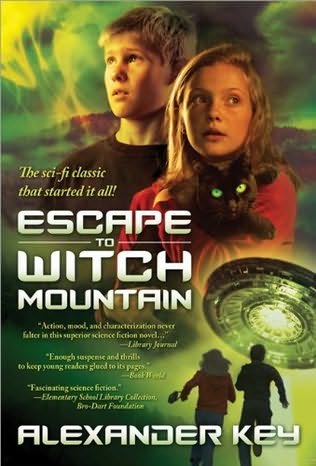
SDG here with a Decent Films update.
Yesterday I posted my review of Disney’s new Race to Witch Mountain, along with shorter reviews of the 1975 Escape to Witch Mountain as well as the 1978 sequel Return from Witch Mountain.
In the Race and Escape reviews I also touch on Alexander Key’s original 1968 book Escape to Witch Mountain, which I first read around the same time that I saw Return to Witch Mountain in theaters. I honestly don’t remember which I encountered first.
What I do remember is that I didn’t encounter the first Disney film until long after I had read the original book and seen the second film — and that, partly because of that, I found the first film disappointing.
The book was much grittier and more serious in tone than the film. In the book, the orphaned heroes have had various brushes with the law (Tony has been in trouble for fighting, and Tia was arrested for breaking and entering, though in fact she had gone into a store after hours to free a cat from a trap). Hackett House, the orphanage where the children are taken after their guardian dies, is more like a juvenile hall, and the matron is a world-weary, suspicious woman nothing like the kindly matron in the Disney film. Bullying Truck isn’t just a bratty twerp, but a serious thug who draws a shiv on Tony and gives him a couple of vicious cuts before Tony can disarm him.
On the other hand, the kids are aided in the book by a heroic Catholic priest, Father O’Day. Young, handsome, forceful, with broad shoulders and a crew cut, Father O’Day is immediately sympathetic to the plight of the kids, believes them implicitly — and isn’t above going out on a limb to help them evade their adult pursuers, even though legally the adults have custody of the children.
O’Day is meant to be pious and devout, crossing himself more than once in conversation with the siblings — a reference that, reading the book as a young Protestant, I literally didn’t understand; I had no idea it referred to the sign of the cross, and might not have known what that was — and imprecating against his “sworn enemy” the devil. One line, though, suggests that he may regard the devil as a non-personal reality: “Don’t think of him as a personage. Think of him as a disease.” (Key apparently described himself as a “freethinker” (source), but may have had some religious sensibilities, and surely meant his portrayal of the priest to be entirely positive.)
Possibly O’Day thought the priest character might help make it clear to readers that the “witchy” book title isn’t meant to suggest that the children’s powers are really occult, though some adult characters in the book do consider them “witch people” and there is even a witch hunt.)
In general, Father O’Day would have been right at home in a Golden Age Hollywood film, but in 1975 he didn’t make the cut. Presumably meant as an homage, the film’s “Jason O’Day” (Eddie Albert) feels to me like adding insult to injury, as if they were making a point of replacing the priest with a religiously unspecified character. (That’s Eddie Albert in the book cover photo above — ironically, since his character doesn’t exist in the book!)
Anyway, Father O’Day was certainly important in the version of the story I first read, and he made an impression on me, along with the Catholicism of J.D. Fitzgerald’s The Great Brain books that I was also reading at the time. (A year or two later, when my family started attending an Episcopal church, I felt that I already knew something of this world from my reading, and had a leg up on my siblings in that respect.)
Incidentally, like nearly all of Key’s books, Escape to Witch Mountain is out of print … and you can’t get it used online for less than about $20. It’s a good read for a kid, but not that good. It’s worth checking out of the library, though.
Oh, I also read the novelization of the second movie as a kid, and liked it pretty well at the time. At Arts & Faith a friend recently remarked on a device added by the novelist: “It used the conceit of an ‘inner Tony’ (the real Tony, trapped inside his own skull) and an ‘outer Tony’ (under the doctor’s control) and gives the inner Tony lots of angst-ridden internal monologue.” I remember that: It was neat, and compensated somewhat for the film’s most nagging weakness: The character of Tony is completely sidelined for nearly the whole story.
My review of Escape to Witch Mountain
My review of Return to Witch Mountain
My review of Race to Witch Mountain
My library has the book, so I put in a request for it. Since I haven’t seen the movies, but plan to, I wonder how I will feel about them after reading the book.